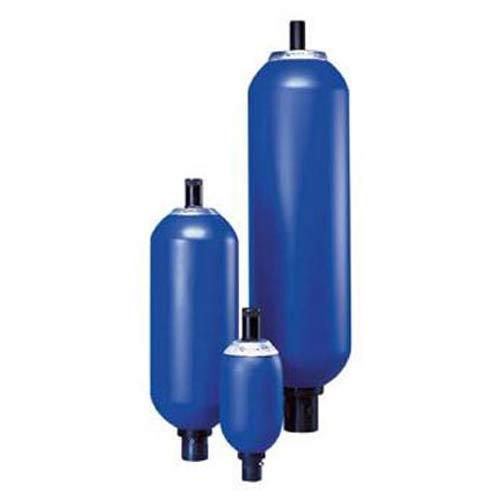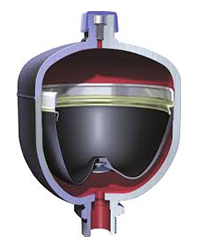Hydraulic Accumulator
Hydraulic Accumulator
The
hydraulic accumulator is a device used for storing the energy of the liquid in
the form of pressure energy, which may be supplied for any sudden or
intermittent requirement.
Or
A hydraulic accumulator is a pressure storage
reservoir in which a non-compressible hydraulic fluid is held under the
pressure that is applied by an external source of mechanical engineering. The
external source can be an engine, a spring, a raised weight or a compressed
gas.
In
the case of hydraulic lift or the hydraulic crane, a large amount of energy
required when lift or crane is moving upward. This energy is supplied from
hydraulic accumulator. But when the lift is moving downward direction, no large
external energy required & at that time the energy from the pump is stored
in the accumulator.


History of Hydraulic Accumulator
1846- First Hydraulic accumulator was made
by William Armstrong, a
crane powered by water of town mains
at Newcastle, United Kingdom.
1852- Armstrong used Grimsby
Dock Tower for the constant pressure
for cranes, lock gates and sluices.
Parts of Hydraulic Accumulator
1. Fixed Vertical Cylinder
2. Sliding Ram
3. Pump
4. Pipes
5. Weight
Construction of Hydraulic Accumulator
The
Hydraulic accumulator consists of a fixed vertical cylinder containing a
sliding ram. A heavy weight is placed on the ram. The inlet of the cylinder is
connected to the pump which continuously supplied water under pressure to the
cylinder. The outlet of the cylinder is connected to the machine (Which may be
lift or crane etc).
Types
of Accumulator
1. Hydraulic Accumulator
(a) Grimsby Dock Tower Accumulator
(b) Raised Weight Accumulator
(c) Spring type Accumulator
2. Pneumatic Accumulator
(a) Bladder type accumulator
(b) Diaphragm type accumulator
(c) Piston type accumulator
(d) Metal bellow type accumulator
1. Hydraulic Accumulator
(a) Grimsby Dock tower Accumulator
Grimsby Dock Tower is hydraulic
accumulator is used for the purpose of
containing a 30,000 UK gallon (136 m3
)
hydraulic wrought iron reservoir at a
height of 300 feet (91 m) to provide
power for lock gates and cranes of
Grimsby Dock.It uses hydraulic head.It delivers constant pressure to the
output.

(b) Raised weight Accumulator-
A raised weight accumulator consists
of a vertical cylinder containing fluid
to the hydraulic line.The cylinder is closed by a piston on
which a series of weights are placed
that exert a downward force on the
piston and thereby energizes the fluid
in the cylinder.Gravity acts on the weight to
pressurize the hydraulic system fluid,
thus storing energy.

(c) Spring type Accumulator-
It uses the energy stored in springs to create a constant force on the liquid contained in an adjacent ram assembly.As a spring is compressed to the maximum installed length, high pressure value of the liquid in a ram assembly is established. As liquid under pressure enters the ram cylinder, causing a spring to compress, the pressure on the liquid will rise because of the increased loading required to compress the spring.
2. Pneumatic Accumulator or Compressed gas or gas charged closed Accumulator-
It is widely used accumulator in present scenario.It is popularly known as “hydro-pneumatic
accumulator”. It apply force to the liquid by using a
compressed gas that acts as the spring. It uses inert gas (nitrogen) under pressure that provides
the compressive force on fluid.
(a) Metal
bellow type Accumulator-
The metal bellows accumulator is
similar to bladder type, expect the
elastic is replaced by a hermetically
sealed welded metal bellows. Fluid may be internal or external to
the bellows. It is used when a fast response time is
not critical, yet reliability is important. Metal bellow types are pre-charged by
supplier and then permanently sealed
leading to a maintenance free
accumulator.


(b) Bladder
Accumulator-
Bladder accumulators are cylinders that contain a rubber bladder. Hydraulic oil is kept under pressure when the bladder is inflated with an inert compressed gas, often nitrogen. When a ride needs a quick burst of power, a valve opens and releases the pressurized hydraulic fluid.
The Bladder Accumulator are two types-
a. Low
pressure Bladder Accumulator
b. High
pressure Bladder Accumulator
(c) Piston
Accumulator-
Piston accumulators are metal tubes with an enclosed piston(Figure 2). One side of the piston is charged with a pressurized gas and the other side with hydraulic oil. When the ride requires additional power, the pressurized gas pushes against the piston which forces hydraulic oil back into the ride’s power unit.
The Piston Accumulator are two types-
a. Low
pressure piston Accumulator
b. High
pressure piston Accumulator
(d) Diaphragm
Accumulator-
A similar to bladder type, expect an elastomeric
diaphragm is used in place of a bag.This would typically reduce the usable volume of the
accumulator, so the diaphragm accumulator may not
have volume capacity of a bladder accumulator. Diaphragm accumulator may be spherical or cylindrical. The main difference with bladder accumulator is an
increased maximum compression ratio of approximately
8:1 It is low weight, compact design and good for shock
applications (good response characteristics)


The Diaphragm Accumulator are two types-
a. Welded
type diaphragm accumulator
b. Threaded
type diaphragm accumulator
Working of Hydraulic Accumulator
The
ram is at the lowest position in the beginning. The pump is supplies water
under pressure continuously. If the water under pressure is not required by the
machine (Lift or Crane), the water under pressure will be stored in the
cylinder. This will raise the ram on which heavy weight is placed. When the ram
is at uppermost position, the cylinder is full of water & accumulator has
stored the maximum amount of pressure energy. When the machine ( Lift or Crane)
required a large amount of energy, the hydraulic accumulator will supply this
energy & ram will move in the downward direction.
Capacity of Hydraulic Accumulator
It’s
defined as the maximum amount of hydraulic energy stored in the accumulator.
Let A= Area of sliding ram
L=
Stroke or lift of the ram
P=
Intensity of water pressure supplied by the pump
W=
Weight placed on the ram
We
know
W =
Intensity of pressure × Area of ram = p × A
The
work done in lifting of ram = W × L = p × A × L
The
work done in lifting the ram is also the energy stored in the accumulator &
energy stored is equal to the capacity of the accumulator.
Capacity
of accumulator = Work done in lifting of ram = p
× A × L
Or p
× V
Where
V= Volume of the accumulator = A × L
Where Accumulator Used?
Accumulators can be applied creatively in any number of situations, including:
Emergency and safety: An accumulator which is kept constantly under
pressure is valuable in the event of an electrical power failure as it can provide
flow and pressure to perform an additional function or complete a machine
cycle.
Shock or pulsation dampening: An accumulator can be used to cushion the
pressure spike from sudden valve closure, the pulsation from pumps or the load
reaction from sudden movement of parts connected to hydraulic cylinders.
Leakage compensation: An accumulator can be used to maintain pressure
and make-up for lost fluid due to internal leakage of system components
including cylinders and valves.
Thermal expansion: An accumulator can absorb the pressure differences
caused by temperature variations in a closed hydraulic system.
Noise reduction: An accumulator is effective at reducing hydraulic system
noise caused by relief valves, pump pulsations, system shock and other circuit
generated noises.
Energy conservation: An accumulator can be used to supplement a pump
during peak demand thereby reducing the size of the pump and motor
required. The accumulator is charged during low demand portions of the pump
cycle time and then discharges during the high demand portions of the system.
Improved response times: An accumulator (bladder type) has virtually
instantaneous response time that can provide fluid very quickly to fast-acting
valves such as servos and proportional to improve their effectiveness
Advantages of Hydraulic Accumulator
1. Fast acting.2. Not susceptible to contamination.
Disadvantages of Hydraulic Accumulator
1. Compressed ratio is limited approximately 4:1.2. Bladder failure.
Application of Hydraulic Accumulator
Accumulators are devices used to store fluid power to do the following:1. Dampen pulsations and shocks of a periodic nature
2. Increase the speed of the operational circuit.
3.Clamping devices to hold the jaw vices and fixtures
4. Standby power supply circuits.
5. Surge reduction circuits
6. Agricultural Machinery & Equipment
7. Forestry Equipment
8. Oil Field & Offshore
9. Machine Tools and Off- Road Equipment
10. Mining Machinery & Equipment
11. Mobile & Construction Equipment
12. Suspension in vehicles









Comments
Post a Comment